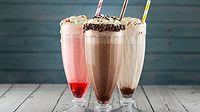Polar Brewing
Reinventing the Venezuelan beer market
By Enrique Saez
The brewing business in Venezuela has turned out to be tremendously exciting for many reasons. Beverage Industry’s sister publication Industria Alimenticia was welcomed in the Caracas office of Eduardo Hernández, director of the beer and wine business for Polar Cos., the leader in the Venezuelan market for beer and maltas, or non-alcohol malt beverages, and one of the most important breweries in South America. Hernández explains the characteristics of what he considers an exciting market.
“Here we make 2.3 million liters per year with
three companies, two local and one international,” he says. “Up
until 2000, it was a business where we practically had a 3 to 5 percent
annual growth rate and until that year there was only one brand, most
popularly known as Polarcita [an endearing term for its flagship Polar
brand].” That brand has been around for 60 years, since the company
was founded in 1941.
Reinvention through new introductions
The past five years have represented an entire
reinvention process for the brewery, multiplying the number of brands and
introductions. The popular “Polarcita” was passed as the market
leader, and now has a market share of 8 percent. That brand has gone on to
be part of a portfolio in which a new brand, Ice, dominates 49 percent of
the market, the Light variety has 15 percent and Solera Light has 11
percent – and all of these belong to Polar.
“The market that had only one brand, today has
proliferated to 10. Five brands give Polar Brewing a market share of 75
percent. Four brands from Regional Brewing equal 16 percent of the market
and the Brahma brand from AmBev holds 9 percent of the total beer market in
Venezuela. This produced a change in the consumer,” Hernández says.
This segmentation of the Venezuelan brewing universe
is due, according to this executive, to the elevated level of consumption
of beer per capita in Venezuela — between 85 and 87 liters annually,
higher than even the United States.
“The consumer started to look for smoother beers
that differed by the lesser grade of alcohol and bitterness. In that
context, the second brand was produced, which permitted an increase in the
consumption of beer,” Hernández explains.
Another aspect to emphasize in the development of the
beer portfolio, was the making of a Venezuelan beer produced with barley
malt, making it lighter and easier to drink, which was a great achievement
for the master European beer-makers, principally Germans, who arrived in
Venezuela decades ago.
“They didn’t become as light as American
beers, but in relative terms they are quite smoother than they were years
ago,” Hernández says.
The smoother introductions dominate in Venezuela.
These varieties entered slowly into the local market at the change of the
millennium, choosing a transparent bottle opposite predominantly
amber-colored introductions. The company launched the brand Polar Ice in
transparent bottles. The acceptance of the new beer in the market was so
big, it has turned into an icon in the Venezuelan beer market.
Another part of this considerable growth was the
introduction of the Premium brand. In 30 months it has taken a 10 percent
share of the market and significant levels of growth. This,
Hernández comments, was produced by raising the consumption of beer
by women who were looking for a product different from those preferred by
the opposite sex in its formulation and the appearance of the packaging.
Without any doubt, what caught the most attention from
analysts in the beverage sector was how
Polar maintained rapid pace in launching new introductions.
One of the successes for Polar was to transform a
single-brand market into a portfolio with nearly 40 varieties of
introductions and the diversification of packaging in a commercial
environment in which the predominant package is returnable glass. The
returnable introductions concentrate on 222- and 330-ml. sizes, while the
non-returnables use a more extensive range from 250 to 600 ml.
Internationalizing ‘malta’
For many, Polar is synonymous with malta, or malt-based non-alcohol
beverages. This is the second segment in which
the company is a leader, with a portfolio of two brands and 10 new
packaging introductions. Because of the local predominance and natural qualities of the product
– it is 100 percent natural, refreshing and has good nutritional
value – the company is undertaking strategy of international
expansion. Fernando Rubio, a professional in the area of maltas for 21 years, explains the
growth strategy of maltas outside Venezuela.
“We have begun to enter the Puerto Rican market.
It is the biggest consumer [of maltas] per capita in the world. Our next challenge is to
consolidate the Carribbean and expand into other states in the United
States.” In Venezuela, as in international markets where they are
present, the maltas are
distributed under their own brands, Maltín Polar or Malta Polar,
which is produced in four plants.
The maltas business uses the same sales force as the beer business and
the same distribution systems. “Generally, we reach 150,000 clients.
We have clients that sell beer and malta, such as liquor stores, and others that only distribute malta, which is the case with
bakeries,” Rubio says.
In addition, the maltas, along with some of the beer brands, are available on all
the islands in Caribbean, Columbia, Miami and New York City.
The heart of production
A visit to Polar Brewery
could not be complete without getting to know the plant in San
Joaquín, in the suburbs of Valencia, one of the four multi-product
plants in the company. Engineer Carlos De Lima, manager of the plant and a
master brewer trained in the United States and Germany, explained the
potential of the eighth-ranked brand on the worldwide level. The company
has a capacity of 23 million hectoliters between the four plants.
“This plant is the largest of the group and has
an installed capacity of 8 million hectoliters. The market in the center of
the country is one of the largest and is one with the most expansion. The plans for growth
and diversification of the portfolio are ambitious,” De Lima says.
De Lima explains the German tradition prevails in the
Polar Brewery, fundamentally in the area of manufacturing. The company has
had a tradition of employing master beer-makers
from Germany, and presently is training young, professional Venezuelans in
German and Spanish universities.
As was expected, the transition in the portfolio of
products created considerable production changes and renovations. The San
Joaquín plant had to adapt to the proliferation of products,
incorporating five types of distinctive beers as well as Maltín
Polar and Maltín Light.
“This is one of the most profound changes that
we have made in the past few years, with movement toward non-returnable
products. Since the first half of May last year, we were manufacturing an
annual volume of 6 percent non-returnable beer. Our plant is now the
location for more than 20 percent, including Maltín Polar and its
production for export in non-returnable cans and bottles. This signifies a
great change in the handling of bottles and equipment,” De Lima says.
A total of seven filling lines are dedicated to
returnable bottles. The latest addition is a filling line for returnable
bottles with a capacity of 2,000 bottles per minute.
The San Joaquín plant counts on one line for
the packaging of cans, for which the market oscillates between 6 and 8
percent and has a tendency for growth. Polar Brewing relies on its own
subsidiary business for the production of cans, lids and printing, which
supplies the four plants in the group and has plans for exporting to
countries in the nearby Caribbean.
Enrique Saez is managing
editor of Industria Alimenticia magazine, Beverage
Industry’s Spanish-language sister publication.


